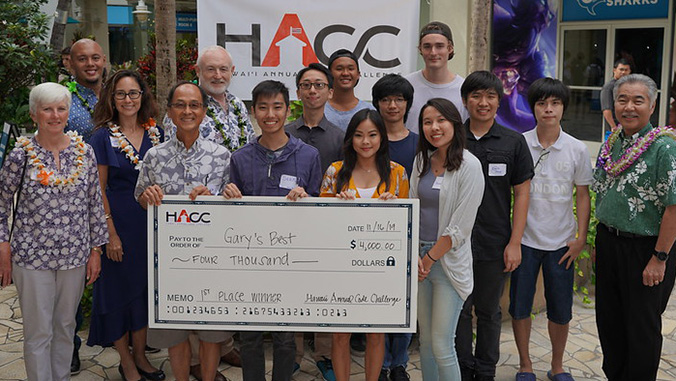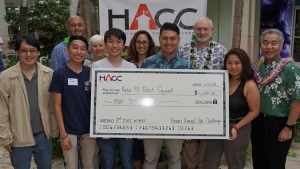
University of Hawaiʻi at Mānoa teams won first and third prize at the Hawaiʻi Annual Code Challenge (HACC) on November 16. The winning team, called Gary’s Best, came up with an innovative solution for a challenge sponsored by the State Office of Energy and Hawaiian Electric Company (HECO). UH Mānoa team Area 51 Raid Squad took third place. Twenty nine teams, including high school teams, participated in the 2019 HACC. Gary’s Best won $4,000, and Area 51 Raid Squad won $1,000.

The challenge was to create a dashboard displaying the health of an electric vehicle charging station using key metrics developed from charging data analysis.
The UH Mānoa teams participated in HACC through one of Professor Philip Johnson’s fall semester information and computer science (ICS) class. ICS senior and Gary’s Best team member Matthew Lam, didn’t know what to expect for his first competition.
“The most nerve wracking thing was seeing the other teamsʻ progress over the four-week challenge,” he said.
Gary’s Best wanted to fulfill all the requirements of the challenge while also showing off their diverse skill sets. Their HECO Rewards app would allow users to submit feedback at electric car charging stations when they encounter a problem, either with the use of the charging station or with the payment system. The user would be given HECO Rewards for their submission that they could redeem from HECO at a later time. The team created a dashboard that combined the real-time feedback with historical data to analyze and predict the health of charging stations around the island.
One area that set Gary’s Best apart was the hardware element of their final project. The small scanner at each charging station would capture and send additional data to HECO for analysis.
“This year’s HACC once again demonstrates the ability of UH students to innovate and address significant social problems in Hawaiʻi,” said Johnson. “In only four weeks, they uncovered an important gap in the [HECO-supplied] data set, and designed a small hardware device coupled with artificial intelligence software to automatically gather additional information about the electric vehicles getting charged. The improved data set provides new opportunities to learn how to increase electric vehicle use in Hawaiʻi, an essential step towards the goal of 100 percent renewable energy in Hawaiʻi by 2045.”
The team was comprised of ICS students Lam, Sean Takafuji, Joshua Nishiguchi, Mercedez Castro, Irene Ma, Nixon King Ko, Edwin Zheng, and electrical engineering student Frendy Lio Can. STAR-GPS programmer Devin Dennis assisted the project, and physics Professor Pui Lam consulted on the project. The name, “Gary’s Best” refers to IT Specialist Gary Rodwell who developed UH’s nationally recognized STAR-GPS registration system.
“The majority of our team works on STAR,” said Lam, “and it was a way of paying homage to our mentor.”
More on HACC
The Hawaiʻi Annual Code Challenge generates proof-of-concepts by student, amateur and professional coders to benefit community and state agencies to support sustainability at the idea-phase level, feeding into Hawaiʻi’s innovation ecosystem to promote solutions for community resilience, professional development, local job creation and building local businesses.
HACC breaks the mold of a traditional hackathon, which typically takes place over a single day or weekend. HACC provides an expanded multi-week timeframe meant to encourage interaction between community teams and state department personnel, ultimately resulting in sustainable solutions that are appropriately matched with technologies and platforms in use or being considered by the state. The competition, inspired by Gov. David Ige, is in its fourth year.

